Nadar (photographer)
| Nadar | |
|---|---|
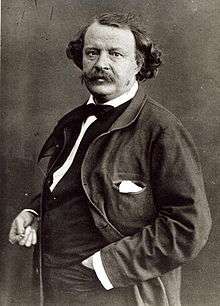 Self-portrait circa 1860 | |
| Born |
Gaspard-Félix Tournachon 6 April 1820 Paris, France |
| Died |
23 March 1910 (aged 89) Paris, France |
| Resting place |
Père Lachaise Cemetery 48°51′36″N 2°23′46″E / 48.860°N 2.396°E |
| Nationality | French |
| Occupation |
Photographer caricaturist journalist novelist balloonist |
| Known for | Pioneer in photography |
| Signature | |
 | |
Nadar was the pseudonym of Gaspard-Félix Tournachon (6 April 1820 – 23 March 1910),[1] a French photographer, caricaturist, journalist, novelist, and balloonist (or, more accurately, proponent of manned flight).
Photographic portraits by Nadar are held by many of the great national collections of photographs.
Life

._-_D%60apr%C3%A8s_les_renseignements_fournis_par_M._Nadar._Gravure_1863.jpg)
Nadar was born in April 1820 in Paris (though some sources state Lyon). His father, Victor Tournachon, was a printer and bookseller. After his father's death, Nadar decided to quit his medical studies for economic reasons. Nadar started working as a caricaturist and novelist for various newspapers. He fell in with the Parisian bohemian group of Gérard de Nerval, Charles Baudelaire and Théodore de Banville. His friends picked a nickname for him: Tournadar, which later became Nadar.[2] His work was published in Le Charivari for the first time in 1848. In 1849, he founded the Revue comique and the Petit journal pour rire.
From work as a caricaturist, he moved on to photography, particularly portraits. He opened his photography studio in rue Saint Lazare in 1854 and moved to 35 Boulevard des Capucines in 1860. Nadar photographed a wide range of personalities: politicians (Guizot, Proudhon), stage actors (Sarah Bernhardt), writers (Hugo, Baudelaire, Sand, Nerval, Gautier, Dumas), painters (Corot, Delacroix, Millet), and musicians (Liszt, Rossini, Offenbach, Verdi, Berlioz).[2] Portrait photography was going through a period of native industrialization and Nadar refused to use the traditional sumptuous decors, preferred natural daylight and despised useless accessories. In 1886, with his son Paul, he did what may be the first photo-report: an interview with the great scientist Chevreul (who was then 100 years old). It was published in le Journal Illustré.[2]
He took his first photographs in 1853 and in 1855 opened a photographic studio at 25 Boulevard des Capucines[3] and in 1858 he became the first person to take aerial photographs. This was done using the wet plate collodion process, and since the plates had to be prepared and developed while the balloon was aloft Nadar experienced problems caused by the chemical action on the plates of gas escaping from the balloon, eventually overcome by using a gas-proof cotton cover over the balloon basket.[4] He also pioneered the use of artificial lighting in photography, working in the catacombs of Paris. He was the first person to photograph above ground with his balloons, as well as the first to photograph below ground, in the Parisian catacombs.

In 1863, Nadar commissioned the prominent balloonist Eugène Godard to construct an enormous balloon, 60 metres (196 ft) high and with a capacity of 6,000 m3 (210,000 cu ft), and named Le Géant (The Giant),[5] thereby inspiring Jules Verne's Five Weeks in a Balloon. Le Géant was badly damaged at the end of its second flight, leading Nadar to the conviction that heavier-than-air machines would be more successful. Later, "The Society for the Encouragement of Aerial Locomotion by Means of Heavier than Air Machines" was established, with Nadar as president and Verne as secretary. Nadar was the inspiration for the character of Michael Ardan in Verne's From the Earth to the Moon.

On his visit to Brussels with Le Géant, on 26 September 1864, Nadar erected mobile barriers to keep the crowd at a safe distance. Crowd control barriers are still known in Belgium as Nadar barriers.
During the Siege of Paris in 1870–71 Nadar was instrumental in organising balloon flights carrying mail to reconnect the besieged Parisians with the rest of the world, thus establishing the world's first airmail service.[6]
In April 1874, he lent his photo studio to a group of painters to present the first exhibition of the Impressionists. He photographed Victor Hugo on his death-bed in 1885. He is credited with having published (in 1886) the first photo-interview (of famous chemist Michel Eugène Chevreul, then a centenarian), and also took erotic photographs. From 1895 until his return to Paris in 1909, the Nadar photo studio was in Marseilles (France).
Nadar died in 1910, aged 89. He was buried in Père Lachaise Cemetery in Paris. The studio continued under the direction of his son and long-term collaborator, Paul Nadar (1856 - 1939).[7]
Works
Towards the end of his life, Nadar published Quand j’étais photographe, which was translated into English and published by MIT press in 2015. The book is full of both anecdotes and samples of his photography, including many portraits of recognizable names.[8]
Gallery

 Caricature of Balzac, 1850
Caricature of Balzac, 1850
.gif)

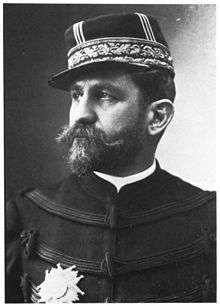

 Le Bris and his flying machine, Albatros II
Le Bris and his flying machine, Albatros II




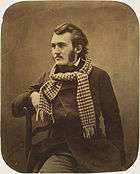 Gustave Doré (1859)
Gustave Doré (1859)
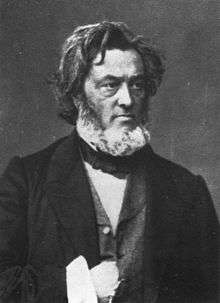 Jules Favre in 1865
Jules Favre in 1865
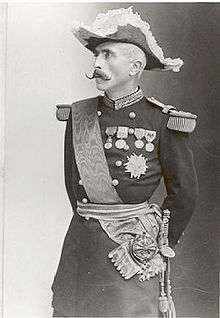 Marquis de Galliffet, the fusilleur de la Commune
Marquis de Galliffet, the fusilleur de la Commune
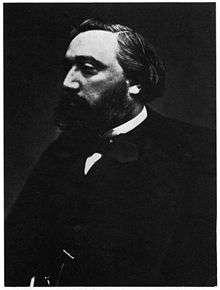 Léon Gambetta in 1870
Léon Gambetta in 1870_by_Nadar.jpg) Charles Gounod in 1890
Charles Gounod in 1890


.jpg)

 Nasser al-Din Shah Qajar, king of Persia 1848-1896
Nasser al-Din Shah Qajar, king of Persia 1848-1896
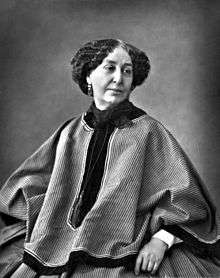 George Sand (1864)
George Sand (1864)

.jpg)
 Émile Zola (1895)
Émile Zola (1895) Nadar (Gaspard-Félix Tournachon) - Self-portrait
Nadar (Gaspard-Félix Tournachon) - Self-portrait- Nadar's son, photographed by Nadar with members of the Second Japanese Embassy to Europe in 1863.
 The future painter Charles Crodel with a sketch-book, photograph by Nadar, Marseille, 21 rue de Noailles, 1905
The future painter Charles Crodel with a sketch-book, photograph by Nadar, Marseille, 21 rue de Noailles, 1905 Self-portrait
Self-portrait
See also
- Prix Nadar, French photojournalism prize given in Nadar's name
- Mononymous person
- Michel Ardan
Citations
- ↑ "La Mort de Nadar". l'Aérophile (in French): 194. 1 April 1910.
- 1 2 3 "Archives de France |". www.archivesdefrance.culture.gouv.fr (in French). Retrieved 2015-10-15.
- ↑ Holmes 2013, p.158
- ↑ Holmes 2013, p.159
- ↑ Holmes 2013, p. 164
- ↑ Holmes 2013, p. 260
- ↑ "Paul Nadar", Getty Museum
- ↑ Adam Begley, The absurd life of Félix Nadar, French portraitist and human flight advocate, The Guardian, 23 December 2015.
References
- Richard Holmes, Falling Upwards: London: Collins, 2013.
External links
| Wikimedia Commons has media related to Félix Nadar. |
- Works by Nadar at Project Gutenberg
- Works by or about Nadar at Internet Archive
- 1867 Caricature of Nadar by André Gill
- Article about Nadar by Bruce Sterling
- Great article about Nadar by Roger Cicala
- Fostinum: Nadar numerous photographs by Nadar
- Nadar at Find a Grave